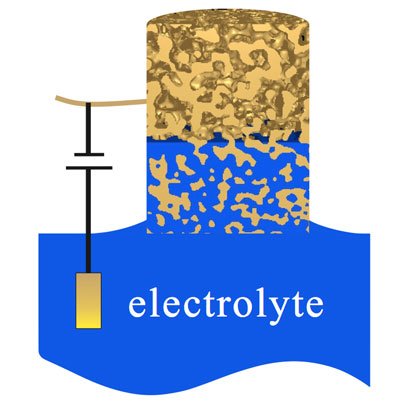| Posted: Aug 20, 2014 | |
Turning nanoporous metal into a nanopump by electrically controlling surface tension |
|
| (Nanowerk Spotlight) The capillarity-driven uptake of liquids by porous solids can be experienced in daily life, e.g., when a sponge or fabric absorbs water. This spontaneous imbibition or capillary rise phenomenon is also one of the most vivid manifestations of the capillarity of liquids: surface tension. | |
| Researchers in Germany have now demonstrated a strategy for achieving control over the imbibition kinetics. Reporting their findings in Nature Communications ("Switchable imbibition in nanoporous gold"), they show that this process can be switched on and off reversibly when nanoporous gold takes the role of the sponge and an electric potential is used to control the surface tension. | |
| "Usually, this infiltration process is out of external control. It is solely determined by the static geometry of the porous host and the fluid parameters, in particular the surface tension and the viscosity of the liquid," Dr. Patrick Huber, a professor at Hamburg University of Technology, explains to Nanowerk. "In our study, we demonstrate that this process can be electrically influenced. Whereas the general phenomenology of electrowetting – the control of the surface tension of a liquid in contact with a solid via electrical potentials – has been known for a long time, we demonstrate it here for the first time for a nanoporous system where the capillary forces are enormous. Depending on the nanopore size, which is easily tunable in gold, they can reach several hundred bars." | |
 |
|
| By electrically controlling surface tension, nanoporous gold becomes a nanopump for aqueous electrolytes. (Image: Huber research group, Hamburg University of Technology) | |
| Huber's research group is exploring the fundamental properties of solids and liquids upon spatial confinement, as encountered in meso- and nanopores or, in a semi-confined manner, at free surfaces of solids and liquids. | |
| This current study was motivated by specific issues posed by fluid dynamics at length scales in the nanoworld: How do liquids behave in geometries, where only a few molecules fit? What happens with macroscopic hydrodynamical concepts – to what extent can they still be used? How can flows at the nanoscale be actively controlled, as nature does in many ways, for example at the transport machinery in biomembranes? | |
| According to Huber, his team's new findings suggest that nanoporous metal may be implemented in devices as a way to manipulate femtoliter to microliter amounts of liquid under control of an electric potential. | |
| "Moreover" he says, "the control voltages are quite low, a few volts only, because we use what is known as direct electrowetting. There is no dielectric layer between the solid and the liquid. The entire pore space is metallic. Hence, wherever the invading liquid front is located in the porous matrix, we can directly apply an electrical potential to the liquid surface and thus change the shape of the menisci from concave (advancing menisci) to planar (arrested menisci)." | |
| Nanoporous gold is a very versatile material and it can be combined with many other technically relevant materials, most prominently silicon. Potential practical applications of this work could be electrical nanopumps without any mechanically moving parts to be used in lab-on-a-chip applications, where in small spaces, very small volumes of liquids have to be accurately handled. | |
| Electrically tunable nanofilters are also feasible, for instance to separate oil from water, where the gold matrix is both the filter and the pump. | |
| Another possibility are nano- and microscale electrical flow valves without any mechanically moving parts and flow sensors, since flow can also induce electrical voltages. | |
| Given the biocompatibility of gold, medical applications could include the design of small implantable pumps for drug delivery. | |
 By
Michael
Berger
– Michael is author of three books by the Royal Society of Chemistry:
Nano-Society: Pushing the Boundaries of Technology,
Nanotechnology: The Future is Tiny, and
Nanoengineering: The Skills and Tools Making Technology Invisible
Copyright ©
Nanowerk LLC
By
Michael
Berger
– Michael is author of three books by the Royal Society of Chemistry:
Nano-Society: Pushing the Boundaries of Technology,
Nanotechnology: The Future is Tiny, and
Nanoengineering: The Skills and Tools Making Technology Invisible
Copyright ©
Nanowerk LLC
|
|
|
Become a Spotlight guest author! Join our large and growing group of guest contributors. Have you just published a scientific paper or have other exciting developments to share with the nanotechnology community? Here is how to publish on nanowerk.com. |
|
